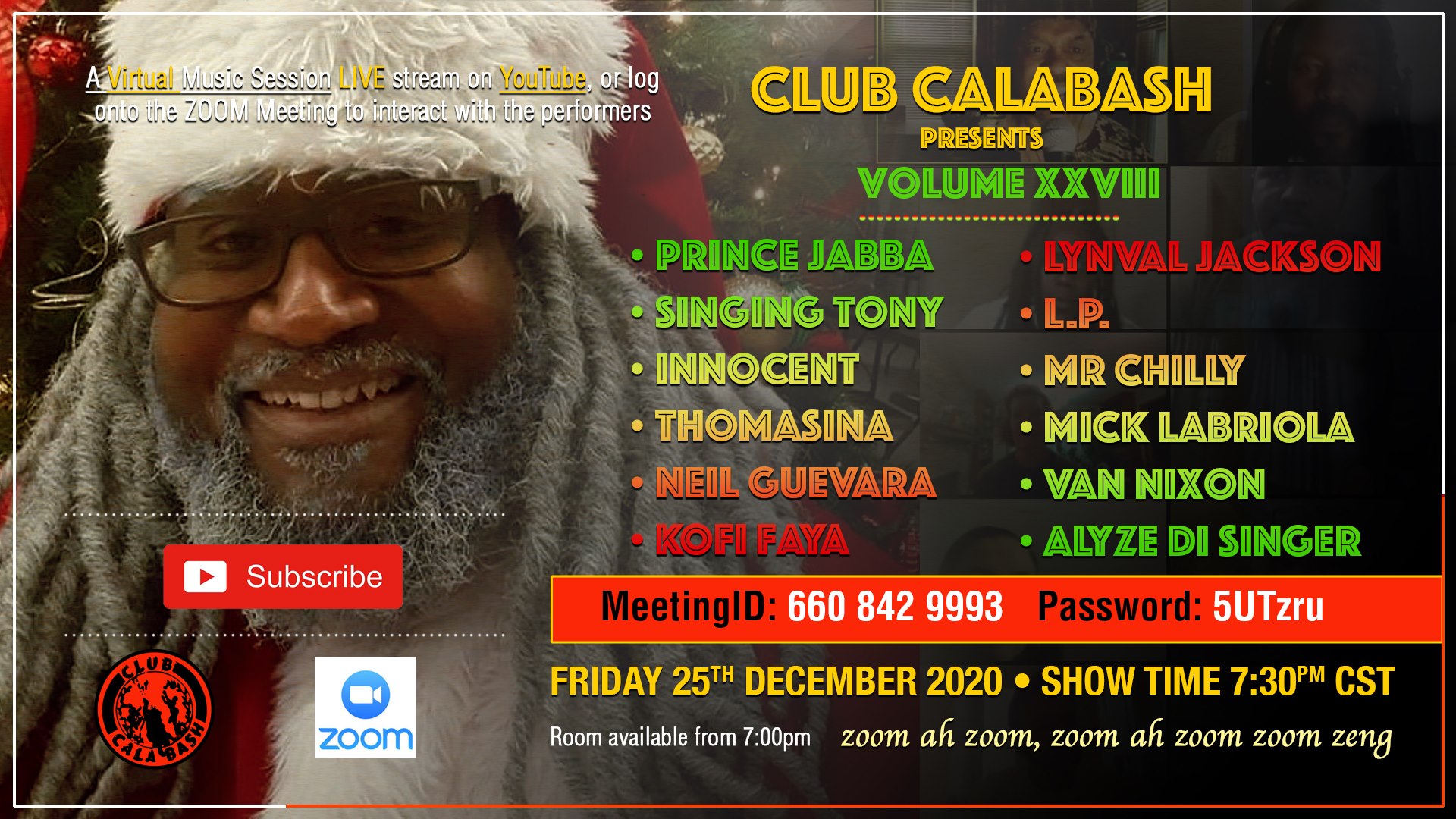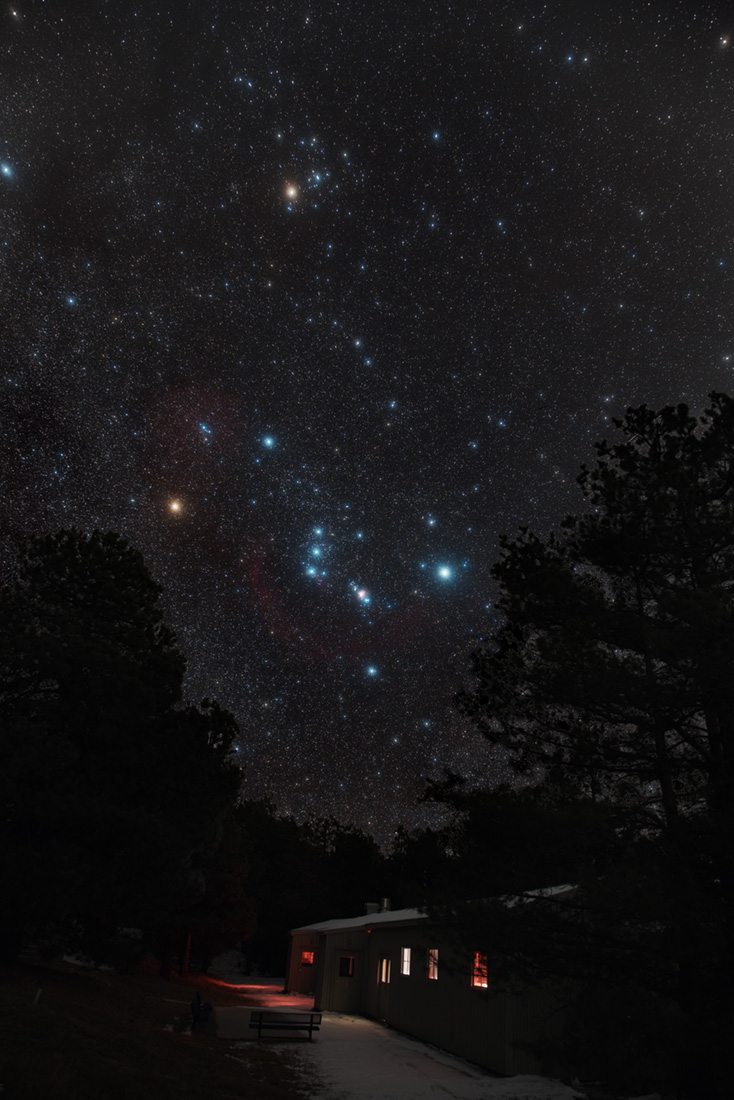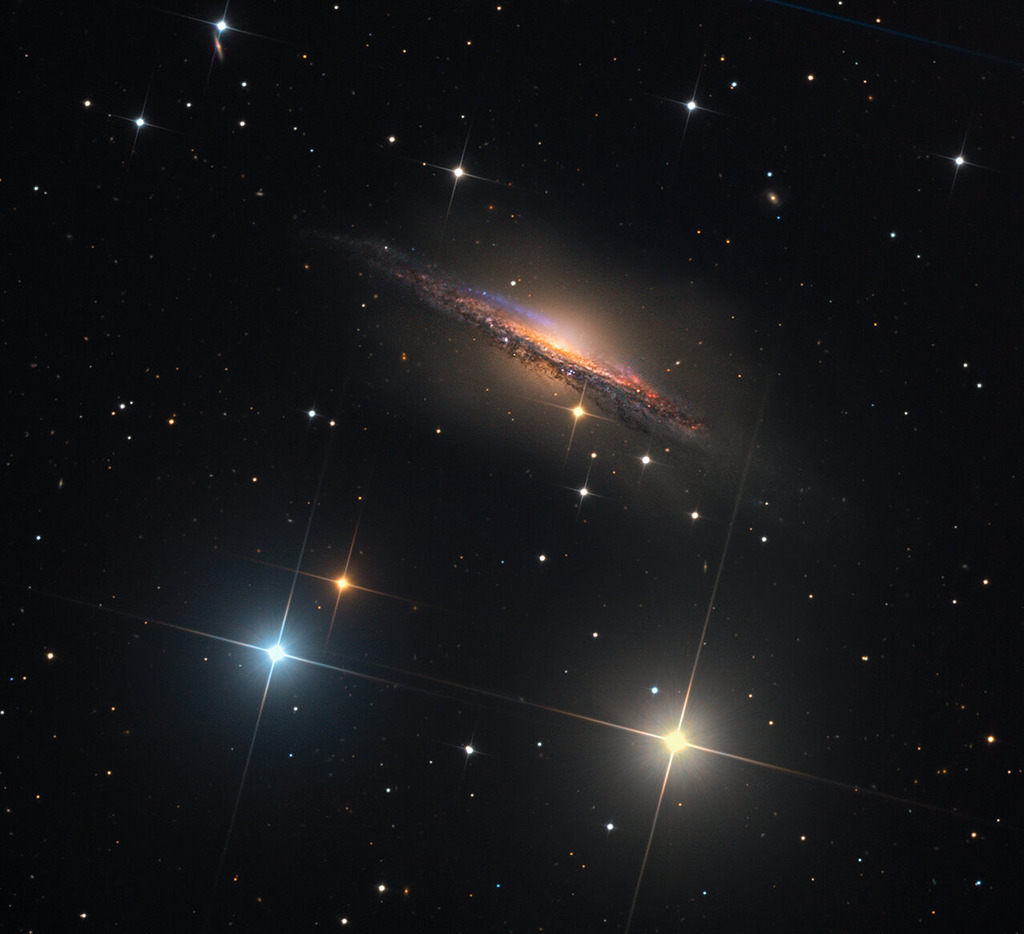Blog
mick will perform two Christmas Meldeys featuring Carlene Davis’s Santa Claus and Deck the Halls ska version

more...
Orion always seems to come up sideways on northern winter evenings. Those familiar stars of the constellation of the Hunter are caught above the trees in this colorful night skyscape. Not a star at all but still visible to eye, the Great Nebula of Orion shines below the Hunter’s belt stars. The camera’s exposure reveals the stellar nursery’s faint pinkish glow. Betelgeuse, giant star at Orion’s shoulder, has the color of warm and cozy terrestrial lighting, but so does another familiar stellar giant, Aldebaran. Alpha star of the constellation Taurus the Bull, Aldebaran anchors the recognizable V-shape traced by the Hyades Cluster toward the top of the starry frame.

David Noel Redding (25 December 1945 – 11 May 2003) was an English rock musician, best known as the bass player for the Jimi Hendrix Experience and guitarist/singer for Fat Mattress.
Following his departure from the Experience in 1969 and the dissolution of Fat Mattress in 1970, Redding formed the short-lived group Road in the United States, which released the self-titled album Road before he re-located to Clonakilty, Ireland, in 1972. There he formed the Noel Redding Band with former Thin Lizzy guitarist Eric Bell, with whom he released two albums. Although by the 1980s Redding had largely removed himself from the music business, he would later perform around his new hometown with wife Carol Appleby.
more...Don Gabriel Pullen (December 25, 1941 – April 22, 1995) was an American jazz pianist and organist. Pullen developed a strikingly individual style throughout his career. He composed pieces ranging from blues to bebop and modern jazz. The great variety of his body of work makes it difficult to pigeonhole his musical style.
Pullen was born on December 25, 1941, and raised in Roanoke, Virginia. Growing up in a musical family, he learned the piano at an early age. He played with the choir in his local church and was heavily influenced by his cousin, Clyde “Fats” Wright, who was a professional jazz pianist. He took some lessons in classical piano and knew little of jazz. At this time, he was mainly aware of church music and the blues.
more...Christophe Kenner (December 25, 1929 – January 25, 1976) was an American, New Orleans-based R&B singer and songwriter, best known for two hit singles in the early 1960s, “I Like It Like That” and “Land of 1000 Dances“, which became staples in the repertoires of many other musicians.
Born in the farming community of Kenner, Louisiana, upriver from New Orleans, Kenner sang gospel music with his church choir. He moved to New Orleans when he was in his teens, to work as a longshoreman.
In 1955 he made his first recordings, for a small label, Baton Records, without success. In 1957, he recorded his “Sick and Tired” for Imperial Records. Kenner’s recording reached number 13 on the Billboard R&B chart. Fats Domino covered it the next year, and his version became a hit on the pop chart. “Rocket to the Moon” and “Life Is Just a Struggle”, both cut for Ron Records, were other notable songs Kenner recorded in this period.
Moving to another New Orleans label, Instant (which was initially called ‘Valiant’ before they discovered the name was already in use), he began to work with the pianist and arranger Allen Toussaint. In 1961, this collaboration produced “I Like It Like That“, his biggest and first pop hit, peaking at number 2 on the Billboard Hot 100 chart (covered in 1965 by the Dave Clark Five), and “Something You Got” (covered by Wilson Pickett, Alvin Robinson, the Ramsey Lewis Trio, Johnny Rivers, Chuck Jackson, Earl Grant, Maxine Brown, Fats Domino, Bobby Womack, The Moody Blues, the Searchers, the American Breed, Fairport Convention, Bruce Springsteen and Jimi Hendrix (1966)). “I Like It Like That” sold over one million copies, was nominated for a Grammy, and was awarded a gold disc by the Recording Industry Association of America.
more...Cabell “Cab” Calloway III (December 25, 1907 – November 18, 1994) was an American jazz singer, dancer, bandleader and actor. He was associated with the Cotton Club in Harlem, New York City, where he was a regular performer and became a popular vocalist of the swing era. His niche of mixing jazz and vaudeville won him acclaim during a career that spanned over 65 years.
Calloway was a master of energetic scat singing and led one of the United States’ most popular big bands from the early 1930s to the late 1940s. His band included trumpeters Dizzy Gillespie, Jonah Jones, and Adolphus “Doc” Cheatham, saxophonists Ben Webster and Leon “Chu” Berry, guitarist Danny Barker, bassist Milt Hinton, and drummer Cozy Cole.
Calloway had several hit records in the 1930s and 1940s, becoming known as the “Hi-de-ho” man of jazz for his most famous song, “Minnie the Moocher“, originally recorded in 1931. He reached the Billboard charts in five consecutive decades (1930s–1970s). Calloway also made several stage, film, and television appearances until his death in 1994 at the age of 86. He had roles in Stormy Weather (1943), Porgy and Bess (1953), The Cincinnati Kid (1965), and Hello Dolly! (1967). His career saw renewed interest in 1980 when he appeared in The Blues Brothers.
Calloway was the first African-American musician to sell a million records from a single song and to have a nationally syndicated radio show. In 1993, Calloway received the National Medal of Arts from the United States Congress. He posthumously received the Grammy Lifetime Achievement Award in 2008. His song “Minnie the Moocher” was inducted into the Grammy Hall of Fame in 1999 and added to the Library of Congress‘ National Recording Registry in 2019. He is also inducted into the Big Band and Jazz Hall of Fame and the International Jazz Hall of Fame.
more...Oscar Frederic Moore (December 25, 1916 – October 8, 1981) was an American jazz guitarist with the Nat King Cole Trio.
The son of a blacksmith, Moore was born in Austin, Texas. The Moore family moved to Phoenix, Arizona, where he began performing with his older brother Johnny, who played both trombone and guitar. Aftger moving to Los Angeles, he participated in his first recording session for Decca as part of the Jones Boys Sing Band led and arranged by Leon René. The group attracted local attention on radio and two short films for MGM directed by Buster Keaton. Soon after, Moore accompanied pianist Nat King Cole at the Swanee Inn in North La Brea, Hollywood. He spent ten years with Cole in the piano-guitar-bass trio format that influenced Art Tatum, Oscar Peterson, Ahmad Jamal.
more...Edward “Kid” Ory (December 25, 1886 – January 23, 1973) was a Louisiana French-speaking jazz trombonist and bandleader. He was born on Woodland Plantation, near LaPlace, Louisiana.
Ory started playing music with homemade instruments in his childhood, and by his teens was leading a well-regarded band in southeast Louisiana. He kept LaPlace, Louisiana, as his base of operations because of family obligations until his twenty-first birthday, when he moved his band to New Orleans. He was one of the most influential trombonists of early jazz.
Ory was a banjo player during his youth, and it is said that his ability to play the banjo helped him develop “tailgate”, a particular style of playing the trombone with a rhythmic line underneath the trumpets and cornets.
When Ory was living on Jackson Avenue, he was discovered by Buddy Bolden, playing his first new trombone, instead of an old Civil War trombone. Ory’s sister said he was too young to play with Bolden.
Ory had one of the best-known bands in New Orleans in the 1910s, hiring many of the great jazz musicians of the city, including the cornetists Joe “King” Oliver, Mutt Carey, and Louis Armstrong, who joined the band in 1919; and the clarinetists Johnny Dodds and Jimmie Noone.
more...Big, beautiful spiral galaxy NGC 1055 is a dominant member of a small galaxy group a mere 60 million light-years away toward the aquatically intimidating constellation Cetus. Seen edge-on, the island universe spans over 100,000 light-years, a little larger than our own Milky Way galaxy. The colorful, spiky stars decorating this cosmic portrait of NGC 1055 are in the foreground, well within the Milky Way. But the telltale pinkish star forming regions are scattered through winding dust lanes along the distant galaxy’s thin disk. With a smattering of even more distant background galaxies, the deep image also reveals a boxy halo that extends far above and below the central bluge and disk of NGC 1055. The halo itself is laced with faint, narrow structures, and could represent the mixed and spread out debris from a satellite galaxy disrupted by the larger spiral some 10 billion years ago.

Raphael Homer “Ray” Bryant (December 24, 1931 – June 2, 2011) was an American jazz pianist, composer, and arranger.
Bryant was born in Philadelphia, Pennsylvania, on December 24, 1931. His mother was an ordained minister who had taught herself to play the piano; his father also played the piano and sang. His brothers were the bass player Tommy, drummer and singer Len, and Lynwood. Ray began playing the piano around the age of six or seven, following the example of his mother and his sister, Vera. Gospel influences in his playing came from being part of the church at this stage in his early life. He had switched from classical music to jazz by his early teens, and played the double bass at junior high school. He was first paid to play when he was 12: “I would play for dances, and they’d sneak me into bars. I’d get four or five bucks a night, which was good money then.” He turned professional aged 14, and immediately joined a local band led by Mickey Collins.
After three years working on and off in Collins’s band, Bryant toured with guitarist Tiny Grimes (1948–49). He was then a solo pianist based in Syracuse, New York for a year. After returning to Philadelphia, he played Dixieland in Billy Kretchmer’s club for around two years. He attracted more attention after becoming house pianist at the Blue Note club in Philadelphia in 1953. He was there until 1956, accompanying many leading players such as Lester Young, Charlie Parker, Miles Davis, and Sonny Stitt. Davis and Sonny Rollins both liked Bryant’s playing enough to record with him in New York in 1955: on Quintet/Sextet and Work Time, respectively.
more...Mohammed Rafi (24 December 1924 – 31 July 1980) was an Indian film playback singer. He is considered as one of the greatest and most influential singers of the Indian subcontinent. Rafi was notable for his versatility and range of voice; his songs varied from fast peppy numbers to patriotic songs, sad numbers to highly romantic songs, qawwalis to ghazals and bhajans to classical songs. He was known for his ability to mould his voice to the persona and style of the actor lip-syncing the song on screen in the movie. He received four Filmfare Awards and one National Film Award. In 1967, he was honored with the Padma Shri award by the Government of India. In 2001, Rafi was honoured with the “Best Singer of the Millennium” title by Hero Honda and Stardust magazine. In 2013, Rafi was voted for the Greatest Voice in Hindi Cinema in the CNN-IBN’s poll.
He recorded songs for over a thousand Hindi films and sang songs in many Indian languages as well as foreign languages, though primarily in Hindi–Urdu and Punjabi, over which he had a strong command. He recorded as many as 7,405 songs in many languages. He sang in many Indian languages – Konkani, Assamese, Bhojpuri, Odia, Punjabi, Bengali, Marathi, Sindhi, Kannada, Gujarati, Tamil, Telugu, Magahi, Maithili, etc. Apart from Indian languages, he also sang songs in many foreign languages, including English, Farsi or Persian, Arabic, Sinhala, Creole and Dutch.
more...Irving Lee Dorsey (December 24, 1924 – December 1, 1986) was an American pop and R&B singer during the 1960s. His biggest hits were “Ya Ya” (1961) and “Working in the Coal Mine” (1966). Much of his work was produced by Allen Toussaint, with instrumental backing provided by The Meters.
Born in New Orleans, Louisiana, Dorsey was a childhood friend of Fats Domino before moving to Portland, Oregon when he was ten years old. He served in the United States Navy in World War II and then began a career in prizefighting. Boxing as a featherweight in Portland in the early 1950s, he fought under the name Kid Chocolate and was not successful, fighting only one time and being knocked out in the second round. He returned to New Orleans in 1955, where he opened an auto repair business as well as singing in clubs at night.
His first recording was “Rock Pretty Baby/Lonely Evening” on Cosimo Mattasa’s Rex label, in 1958. This was followed by the Allen Toussaint-produced “Lottie Mo/Lover of Love”, for the small Valiant label in late 1960 (picked up by ABC Paramount in 1961). These efforts were unsuccessful, but around 1960 he was discovered by A&R man Marshall Sehorn, who secured him a contract with Fury Records, owned by Bobby Robinson. After meeting songwriter and record producer Allen Toussaint at a party, he recorded “Ya Ya“, a song inspired by a group of children chanting nursery rhymes. It went to number seven on the Billboard Hot 100 in 1961, sold over one million copies, and was awarded a gold disc. Although the follow-up “Do-Re-Mi” also made the charts, later releases on Fury were not successful. Dorsey returned to running his repair business, but also released singles on the Smash and Constellation labels in 1963 and 1964.
more...Warren “Baby” Dodds (December 24, 1898 – February 14, 1959) was a jazz drummer born in New Orleans, Louisiana. He is regarded as one of the best jazz drummers of the pre-big band era, and one of the most important early jazz drummers. He varied his drum patterns with accents and flourishes, and he generally kept the beat with the bass drum while playing buzz rolls on the snare. Some of his early influences included Louis Cottrell, Sr., Harry Zeno, Henry Martin, and Tubby Hall. Dodds was among the first drummers to be recorded who improvised while performing.
“Baby” Dodds was the younger brother of clarinetist Johnny Dodds. His mother, who died when he was nine years old, taught him valuable lessons about persistence and putting one’s whole effort into endeavors, and he carried these with him through his career as a jazz drummer. He was born into a very musical family. His father and uncle played violin and his sister played harmonica. In addition, his father was religious and the family regularly sang hymns together. Dodds, in his autobiography The Baby Dodds Story, told the story of making his first drum: “I took a lard can and put holes in the bottom and turned it over and took nails and put holes around the top of it. Then I took some rounds out of my mother’s chairs and made drumsticks out of them”. At age 16, Dodds saved up enough money to buy his own drum set. Although Dodds had several paid teachers during his early years as a drummer, various jazz drummers around New Orleans also influenced him. He started playing in street parades around New Orleans with Bunk Johnson and his band and then got a job playing in Willie Hightower’s band, the American Stars. The band played in various venues around New Orleans, and Dodds recalls hearing many musicians along the way, including Buddy Bolden, John Robichaux, and Jelly Roll Morton. He played with several different outfits including those of Frankie Duson and Sonny Celestin, and he was part of the New Orleans tradition of playing jazz during funeral marches. Dodds describes this experience in his autobiography: “The jazz played after New Orleans funerals didn’t show any lack of respect for the person being buried. It rather showed their people that we wanted them to be happy”.
more...
